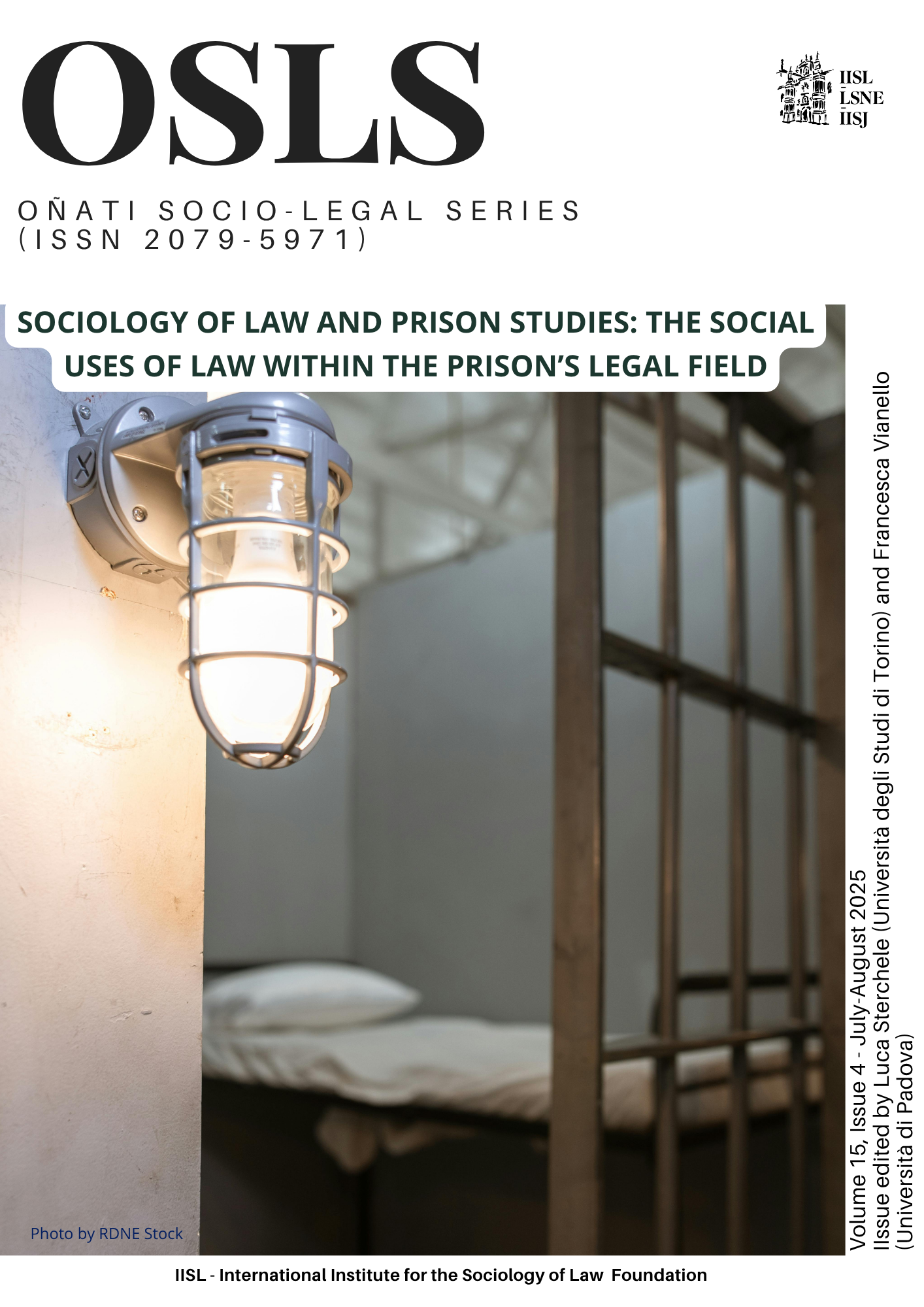Learning and training while serving time
Conflictual dynamics and cooperation techniques between prison actors and vocational experts
DOI:
https://doi.org/10.35295/osls.iisl.1998Keywords:
prison, rehabilitation, vocational training, legal cultureAbstract
The article presents the results of empirical research on vocational training activities within the Italian prison context. The research constitutes an attempt to bring rehabilitation rhetoric into dialogue with the practices that emerged from the interviews conducted with inmates, educators and vocational trainers, through the lens of prison sociology. In particular, the paper delves into the dynamics of professional cultures within the Italian prison system, exploring how norms inherent to the teaching professions intersect with the institutional environment and actors. The aim of this paper is to reconstruct the fragmentary nature of penal control exercised in the prison environment through the recomposition of the framework of interactions occurring among different professional and legal cultures of educators, prison officers and vocational experts.
Downloads
Metrics
Global Statistics ℹ️
|
425
Views
|
480
Downloads
|
|
905
Total
|
|
References
Acocella, I., and Pastore, G., 2020. La «cura» delle relazioni in carcere e «nonostante» il carcere: significati e pratiche nel contesto penitenziario toscano. Autonomie locali e servizi sociali. Quadrimestrale di studi e ricerche sul welfare [online], 3, 539-554. Available at: http://dx.doi.org/10.1447/99925
Allegri, P.A., 2020. La formazione professionale all’interno dell’istituzione penitenziaria, uno studio di caso tra luci e ombre. Autonomie locali e servizi sociali. Quadrimestrale di studi e ricerche sul welfare, 3, 615-629.
Anastasia, S., and Gonnella, P., 2005. Patrie galere: viaggio nell’Italia dietro le sbarre. Rome: Carocci.
Baratta, A., 2019. Criminologia critica e critica del diritto penale. Introduzione alla sociologia giuridico-penale. Rome: Meltemi.
Becker, H., 1967. Whose Side Are We On? Social Problems [online], 14, 3, 239-247. Available at: https://www.sfu.ca/~palys/Becker1967-WhoseSideAreWeOn.pdf DOI: https://doi.org/10.1525/sp.1967.14.3.03a00010
Becker, H., 1987. Outsiders. Saggi di sociologia della devianza, Turin: Gruppo Abele.
Berger, P.L., and Luckmann, T., (with M. Sofri Innocenti and A. Sofri Peretti, trans. and ed.), 1997. La realtà come costruzione sociale, Bologna: Il Mulino.
Bourdieu, P., 1977. Outline of a Theory of Practice [online]. Cambridge University Press. Available at: https://doi.org/10.1017/CBO9780511812507 DOI: https://doi.org/10.1017/CBO9780511812507
Bourdieu, P., 1986. Habitus, code et codification. Actes de la recherche en sciences sociales [online], 64(1), 40-44. Available at: https://doi.org/10.3406/arss.1986.2335 DOI: https://doi.org/10.3406/arss.1986.2335
Bourdieu, P., 1987. The force of law: Toward a sociology of the juridical field. Hastings Law Journal, 38(5), 805–853.
Bozick, R., et al., 2018. Does Providing Inmates with Education Improve Postrelease Outcomes? A Meta-analysis of Correctional Education Programs in the United States. Journal of Experimental Criminology [online], 14, 3, 389-428. Available at: https://doi.org/10.1007/s11292-018-9334-6 DOI: https://doi.org/10.1007/s11292-018-9334-6
Buffa, P., 2013. Prigioni. Amministrare la sofferenza. Turin: Gruppo Abele.
Buffa, P., 2022. Il Confiteor penitenziario. Le opacità e le sconsiderate scelte che facilitano la violenza in carcere. Diritto Penale e Uomo [online], 3/3. Available at: https://dirittopenaleuomo.org/wp-content/uploads/2022/04/Buffa-DPU-confiteor-3-.pdf
Caputo-Levine, D.D., 2013 The Yard Face: The Contributions of Inmate Interpersonal Violence to the Carceral Habitus. Ethnography [online], 14(2), 165-185. Available at: https://doi.org/10.1177/1466138112457299 DOI: https://doi.org/10.1177/1466138112457299
Chappell, C.A., 2004. Post-secondary Correctional Education and Recidivism: A Meta-analysis of Research Conducted 1990-1999. Journal of Correctional Education [online], 55(2), 148-169. Available at: http://www.antoniocasella.eu/nume/Chappel_2004.pdf
Church, T.W., 1982. Examining local legal culture: practitioner attitudes in four criminal courts. Ann Arbor: University of Michigan Library.
Clemmer, D., 1940. The Prison Community. Boston: The Christopher Publishing House.
Cotterrell, R., 2006. Law, Culture and Society. Legal ideas in the mirror of Social Theory. Aldershot: Ashgate.
Crewe, B., 2007. Power, Adaptation and Resistance in a Late-Modern Men’s Prison. British Journal of Criminology [online], 47(2), 256-275. Available at: https://doi.org/10.1093/bjc/azl044 DOI: https://doi.org/10.1093/bjc/azl044
Crewe, B., 2011. Depth, Weight, Tightness: Revisiting the Pains of Imprisonment. Punishment & Society [online], 13(5), 509-529. Available at: https://doi.org/10.1177/1462474511422172 DOI: https://doi.org/10.1177/1462474511422172
Crozier, M., and Friedberg, E., 1995. Attore sociale e sistema. Sociologia dell’azione organizzata. Milan: Etas.
De Giorgi, A., 2002. Il governo dell’eccedenza. Post-fordismo e controllo della moltitudine. Verona: Ombre Corte.
Di Marco, A., and Venturella, M., 2016. Il carcere oltre il carcere. Studi sulla questione criminale [online], 2, 339-349. Available at: http://dx.doi.org/10.3240/84125
Drake, D., 2011. The “Dangerous other” in Maximum-Security Prison. Criminology and Criminal Justice [online], 11(4), 367–382. Available at: https://doi.org/10.1177/1748895811408836 DOI: https://doi.org/10.1177/1748895811408836
Drake, D., Earle, R., and Sloan, J., eds., 2015. The Palgrave handbook of prison ethnography [online]. New York: Palgrave Macmillan. Available at: https://doi.org/10.1057/9781137403889 DOI: https://doi.org/10.1057/9781137403889
Duwe, G., and Clark, V., 2014. The Effects of Prison-based Educational Programming on Recidivism and Employment. The Prison Journal [online], 94(4), 454-478. Available at: https://doi.org/10.1177/0032885514548009 DOI: https://doi.org/10.1177/0032885514548009
Ferreccio, V., and Vianello, F., 2014. Doing research in prison: How to resist institutional pressures. In: K. Lumsden and A. Winter, eds., Reflexivity in Criminological research [online]. London: Palgrave Macmillan, 259-274. Available at: https://doi.org/10.1057/9781137379405_20 DOI: https://doi.org/10.1057/9781137379405_20
Frediani, W., 2018. Un universo di acciaio e cemento. Vita quotidiana nell’istituzione totale carceraria. Rome: Sensibili alle foglie.
Friedberg, E., 1994. Il potere e la regola. Dinamiche dell’azione organizzata. Milan: Etas.
Gariglio, L., 2018. “Doing” Coercion in Male Custodial Settings: An Ethnography of Italian Prison Officers Using Force [online]. London: Routledge. Available at: https://doi.org/10.4324/9781315462691 DOI: https://doi.org/10.4324/9781315462691
Gonnella, P., 2014. Carceri. I confini della dignità. Milan: Jaca Book.
Hawley, J., Murphy, I., and Souto-Otero, M., 2013. Prison Education and Training in Europe. Current State-of-Play and Challenges [online]. Authored for the European Commission by GHK Consulting. Available at: http://www.antoniocasella.eu/nume/Hawley_UE_education_may13.pdf
Liebling, A., 2000. Prison officers, policing and the use of discretion. Theoretical Criminology [online], 4(3), 333-357. Available at: https://doi.org/10.1177/1362480600004003005 DOI: https://doi.org/10.1177/1362480600004003005
Liebling, A., Muir, G., and Rose, G., 1999. Incentives and Earned Privileges in Prison. London: Home Office Research, Development and Statistics Directorate.
Maculan, A., 2022. La galera incorporata. Etnografie della polizia penitenziaria. Santarcangelo di Romegna: Maggioli.
Maculan, A., and Santorso, S., 2018. Quotidianità detentiva: cella, sezione e soggettività recluse. In: E. Kalica and S. Santorso, eds., Farsi la galera: Spazi e culture del penitenziario. Verona: Ombre Corte.
Margara, A., 2004. Il carcere della legge e il carcere che c’è: tendenze, possibili derive, senso delle attività trattamentali. In: S. Migliori, ed., Lo studio e la pena. L’Università di Firenze nel carcere di Prato: rapporto triennale 2000-2003. Firenze University Press, pp. 5-24.
Nally, J.M., et al., 2014. Indiana Industry Sectors that Hire Ex-offenders: Implications to Correctional Education Programs. Journal of Correctional Education, 65(3), 43-65.
Nelken, D., 2004. Using the Concept of Legal Culture. Australian Journal of Legal Philosophy [online], 29(1), 1-26. Available at: https://www.austlii.edu.au/au/journals/AUJlLegPhil/2004/11.pdf
Newton, D., et al., 2018. The Impact of Vocational Education and Training Programs on Recidivism: A Systematic Review of Current Experimental Evidence. International Journal of Offender Therapy and Comparative Criminology [online], 62(1), 187-207. Available at: https://doi.org/10.1177/0306624X16645083 DOI: https://doi.org/10.1177/0306624X16645083
Oggionni, F., 2021. Osservare la complessità del carcere per illuminare le zone d’ombra. In: R. Bezzi e F. Oggionni, eds., Educazione in carcere. Sguardi sulla complessità. Milan: FrancoAngeli, 15-30.
Pavarini, M., 1996. Pena. Enciclopedia delle scienze sociali [online]. Rome: Istituto della Enciclopedia Italiana. Available at: https://www.treccani.it/enciclopedia/pena_(Enciclopedia-delle-scienze-sociali)/
Pavarini, M., 2012. Perché punire?. Antigone. Quadrimestrale di critica del sistema penale e penitenziario, 2, 13-34.
Pennisi, C., 2022. Legal Culture and empirical research: Improving the socio-legal character of the sociology of law. Oñati Socio-Legal Series [online], 12(6), 1347–1357. Available at: https://doi.org/10.35295/osls.iisl/0000-0000-0000-1323 DOI: https://doi.org/10.35295/osls.iisl/0000-0000-0000-1323
Prina, F., 2018. Il penitenziario come campo di osservazione privilegiato delle sfide dell’amministrare. In: C. Pennisi, F. Prina and M. Raiteri, eds., Amministrazione, cultura giuridica e ricerca empirica. Santarcangelo di Romegna: Maggioli.
Prina, F., and Vianello, F., 2020. Carcere e dintorni: il contributo della ricerca su condizioni detentive, diritti e spazi di innovazione. Autonomie locali e servizi sociali. Quadrimestrale di studi e ricerche sul welfare, 3, 463-480.
Ronco, D., 2016. La competizione tra i reclusi. L’impatto della scarsità di risorse e della logica del beneficio sulla comunità carceraria. Etnografia e ricerca qualitativa, 9(2), 211–226.
Salle, G., and Chantraine, G., 2009. Le droit emprisonné? Sociologie des usages sociaux du droit en prison. Politix [online], 87(3), 93–117. Available at: https://doi.org/10.3917/pox.087.0093 DOI: https://doi.org/10.3917/pox.087.0093
Sallée, N., and Chantraine, G., 2020. Imprisoned Rehabilitation: Educators, Guards and Jurisdictional Conflicts in a French Youth Prison. Justice Power, Resistance. The Journal of the European Group for the Study on Deviance and Social Control, 4(1), 4-19.
Sarzotti, C., 1999. Codice paterno e codice materno nella cultura giuridica degli operatori penitenziari. In: A.R. Favretto e C. Sarzotti, eds., Le carceri dell’Aids. Indagine su tre realtà italiane. Turin: L’Harmattan Italia.
Sarzotti, C., 2000. Carcere e cultura giuridica: L’ambivalenza dell’istituzione totale. Dei delitti e delle pene, 1(2), 77–126.
Sarzotti, C., 2010. Il campo giuridico del penitenziario: appunti per una ricostruzione. In: E. Santoro, ed., Diritto come questione sociale. Turin: Giappichelli.
Sbraccia, A., and Vianello, F., 2016. Introduzione. Carcere, ricerca sociologica, etnografia. Etnografia e ricerca qualitativa, 2, 183-210.
Sbraccia, A., and Vianello, F., 2022. Legal culture and professional cultures in the prison system. Oñati Socio-Legal Series [online], 12(6), 1463–1491. Available at: https://doi.org/10.35295/osls.iisl/0000-0000-0000-1324 DOI: https://doi.org/10.35295/osls.iisl/0000-0000-0000-1324
Scott, D., 2008. Creating Ghosts in the Penal Machine: Prison Officer Occupational Morality and the Techniques of Denial. In: J. Bennett, C. Crewe and A. Wahidin, eds., Understanding Prison Staff. London: Willan.
Scraton, P., and McCulloch, J., eds., 2009. The violence of incarceration [online]. New York/London: Routledge. Available at: https://doi.org/10.4324/9780203892916 DOI: https://doi.org/10.4324/9780203892916
Sparks, R., Hey, W., and Bottoms, A., 1996. Prisons and the Problem of Order [online]. Oxford: Clarendon Press. Available at: https://doi.org/10.1093/acprof:oso/9780198258186.001.0001 DOI: https://doi.org/10.1093/acprof:oso/9780198258186.001.0001
Sykes, G., 1958. The Society of Captives: A Study of a Maximum-Security Prison. Princeton University Press.
Torrente, G., 2016. Mi raccomando non fategli del male. La violenza del carcere nelle pratiche decisionali degli operatori. Etnografia e ricerca qualitativa, 2, 267-283.
Ugelvik, T., 2014. Power and resistance in prison: Doing time, doing freedom [online]. London: Palgrave Macmillan. Available at: https://doi.org/10.1057/9781137307866 DOI: https://doi.org/10.1057/9781137307866
Verdolini, V., 2022. L’istituzione reietta. Spazi e dinamiche del carcere in Italia. Rome: Carocci.
Vianello, F., 2018a. L’istruzione in carcere, tra diritto e privilegio. In: E. Kalica and S. Santorso, eds., Farsi la galera: Spazi e culture del penitenziario. Verona: Ombre Corte
Vianello, F., 2018b. Norme, codici e condotte: la cultura del penitenziario. Gli attori sociali di fronte alla criticità dell’ambiente carcerario. Sociologia del Diritto [online], 3, 67-86. Available at: https://doi.org/10.3280/SD2018-003004 DOI: https://doi.org/10.3280/SD2018-003004
Vianello, F., 2019. Sociologia del carcere. Un’introduzione. Rome: Carocci.
Wright, R., 2005. Going to Teach in Prisons: Culture Shock. Journal of Correctional Education, 56(1), 19-38.
Published
How to Cite
Issue
Section
License
Copyright (c) 2025 Perla Arianna Allegri

This work is licensed under a Creative Commons Attribution-NonCommercial-NoDerivatives 4.0 International License.
OSLS strictly respects intellectual property rights and it is our policy that the author retains copyright, and articles are made available under a Creative Commons licence. The Creative Commons Non-Commercial Attribution No-Derivatives licence is our default licence and it regulates how others can use your work. Further details available at https://creativecommons.org/licenses/by-nc-nd/4.0 If this is not acceptable to you, please contact us.
The non-exclusive permission you grant to us includes the rights to disseminate the bibliographic details of the article, including the abstract supplied by you, and to authorise others, including bibliographic databases, indexing and contents alerting services, to copy and communicate these details.
For information on how to share and store your own article at each stage of production from submission to final publication, please read our Self-Archiving and Sharing policy.
The Copyright Notice showing the author and co-authors, and the Creative Commons license will be displayed on the article, and you must agree to this as part of the submission process. Please ensure that all co-authors are properly attributed and that they understand and accept these terms.






















